Recent News
MoNA Collaboration at the 2023 American Physical Society Division of Nuclear Physics
March 8, 2024
Several members of the MoNA Collaboration attended the 6th joint meeting between the American Physical Society Division of Nuclear Physics (APS/DNP) and the Physical Society of Japan (JPS), which was held on November 26-December 1, 2023 at the Hilton Waikoloa Village, on Hawaii's Big Island.
| The MoNA Collaboration at the 2023 APS/DNP (Left) and the 2023 Physicists Inspiring the Next Generation (Right). | |
 |  |
TUNL Neutron Beam Experiment
A group of 12 researchers from the MoNA Collaboration, including 5 undergraduate and 2 graduate students, recently visited the Triangle Universities Nuclear Laboratory (TUNL) at Duke University in Durham, NC. The team used an 11-MeV neutron beam from TUNL's tandem accelerator to test prototype neutron detectors. The team had excellent local support by Sean Finch, Forrest Friesen, and Michelle Riemann.
The detectors were built from test kits at Augustana College, Davidson College, Hope College, James Madison University, Michigan State University, and Virginia State University, and consist of plastic scintillators and various configurations of SiPM arrays. Different types of optical coupling and reflective wrapping were used. The collected data will be used in benchmarking current neutron detector simulation tools and play an important role in developing the next generation neutron detector, which was recently approved for funding by the National Science Foundation [https://www.nsf.gov/awardsearch/showAward?AWD_ID=2320400].
Professor Frank positions a SiPM based detector module for testing.
Closeup of test module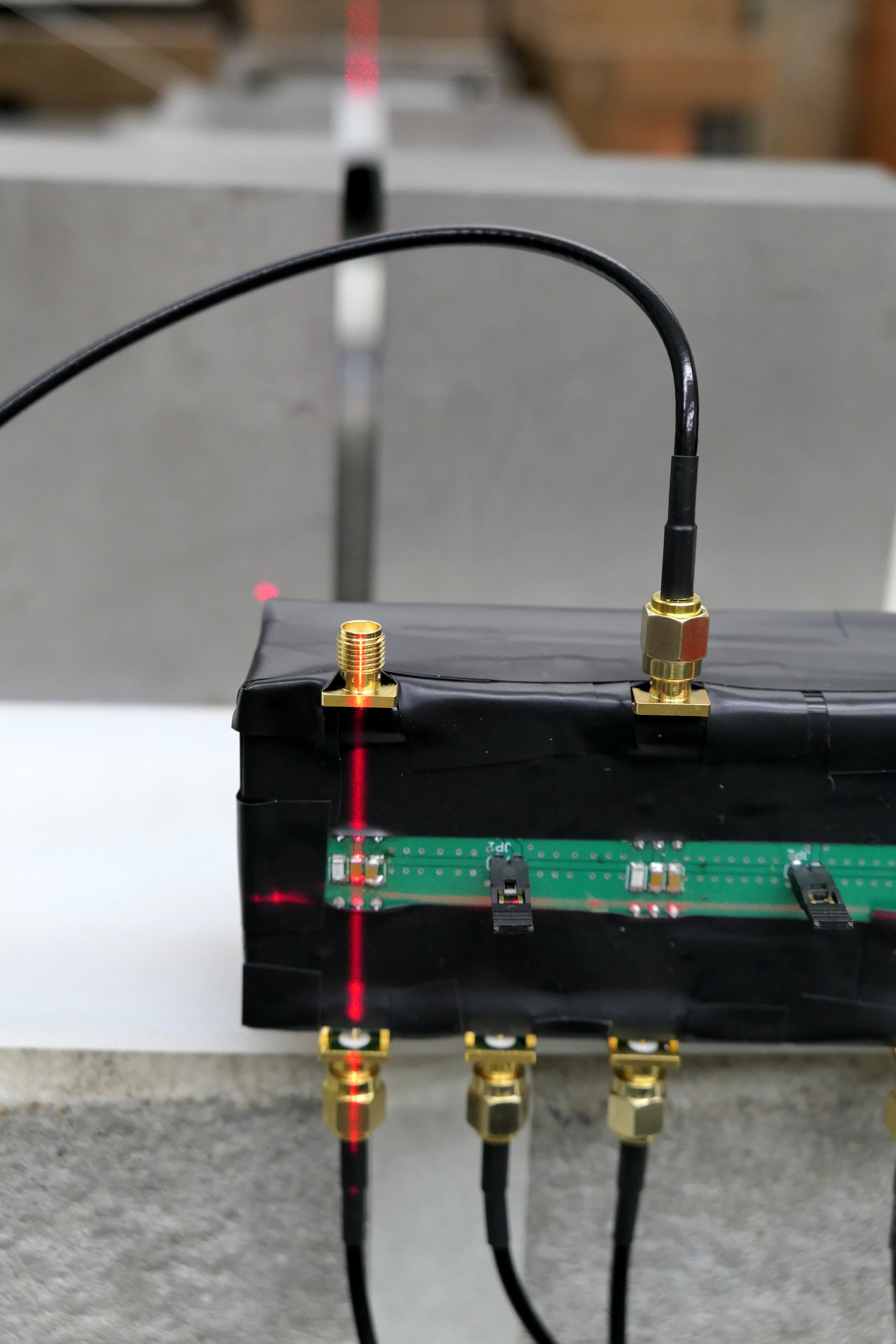
Students, faculty, and staff involved in the TUNL run
Los Alamos experiments
Members of the MoNA collaboration went to the Los Alamos Neutron Science Center (LANSCE) July 24-28, 2023 to help prepare for an upcoming experiment to better understand neutron scattering and detection. The group consisted of participants from Davidson College, Indiana Wesleyan University, Michigan State University, and Virginia State University
The group stands in front of a replica of the Main Gate from the Manhattan Project era in Los Alamos, NM.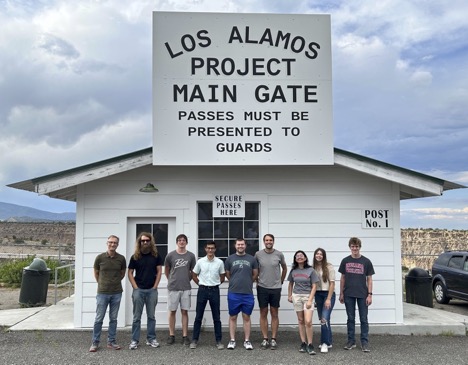
FRIB PAC2
The second Program Advisory Committee (PAC2) of the Facility for Rare Isotope Beams met on March 1-3, 2023. A total of 11,859 facility-use hours were submitted to PAC2 and 4,127 hours (35%) could be approved due to the limited beam time available. The MoNA Collaboration submitted five proposals in partnership with other researchers outside of the collaboration, two of which were approved by the PAC.
The two approved proposals are :
23033 - Investigating the halo structure of 37Mg - A. Revel
23068 - Study of possible p-wave halo in 34Na ground state - B. Monteagudo-Godoy
Those two experiments aim to improve our understanding of phenomena arising when moving away from the valley of beta-stability and in particular on the formation of neutron halos, often observed uniquely in nuclei close to the neutron dripline. Both experiments will shed light on the interplay between deformation, shell evolution, halo formation and coupling to the continuum. The two nuclei of interest, 37Mg and 34Na, will be studied using kinematically complete Coulomb breakup measurement in order to map the dB(E1)/dErel function and extract key information such as the geometrical information of the halo, the neutron separation energy, the ground state and its configuration mixing. The invariant-mass method will be used to reconstruct the relative energy following the Coulomb breakup reaction. The neutron will be detected by the MoNA-LISA array and the recoil fragment will be deflected by the sweeper magnet before to be measured by a set of detectors. In addition, eventual decays towards bound states will be observed using the CAESAR CsI array placed around the target.
SiPM testing for possible next generartion detector
Students and PIs at Davidson College, Virginia State University, Michigan State University, Hope College, and Augustana College are currently constructing and testing SiPMs with plastic scintillators to aid in the design and prototyping of a next generation neutron detector. Custom PCB boards were designed at FRIB and sent to participating MoNA institutions. Davidson College student Ari Maki has been investigating the role of the optical coupling of SiPMs to the scintillators and the reflective wrapping with cosmic rays and collimated gamma rays as part of his honors thesis. Other students have been exploring time and position resolutions, as well as characterizing the performance of different SiPM modules from various vendors.
Scintillator tile with SiPM test board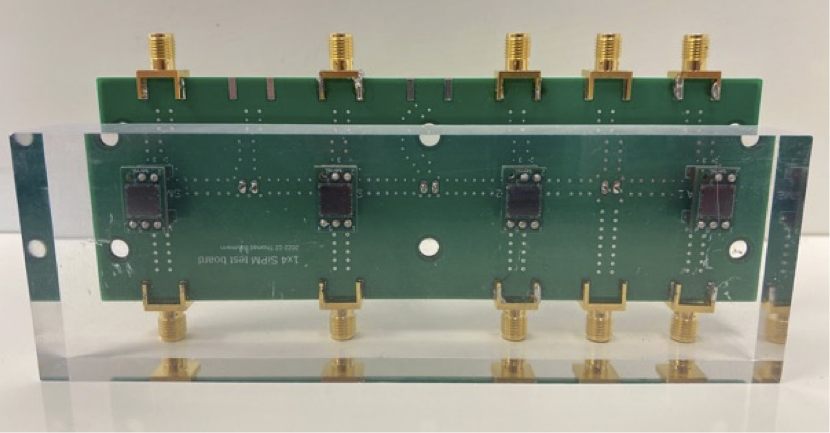
Davidson College student Ari Maki working with a test module
DNP 2022
The members of the MoNA collaboration were happy to get back into in-person conference mode at DNP-2022! This year's DNP was held in New Orleans, October 27-30. The MoNA Collaboration was well represented with several students participating in the CEU poster session and others giving oral presentations. This included twelve undergraduate students from seven institutions and four graduate students from Michigan State University.
MoNA students and faculty at DNP
Henry Webb of Augustana with his poster
CAARI 2022
MoNA graduate student Nico Mendez and PI Thomas Baumann attended the 26th International Conference on the Application of Accelerators in Research & Industry (CAARI 2022) from October 30 to November 3, 2022 in Denton, Texas. The application and detector focused conference brings together scientists, engineers, professors, physicians, and students from all over the world who use particle accelerators in their research and industrial applications. Nico showed “Simulations of the Multi-layer Active target for MoNA Experiments (MAME) with Garfield++” and Thomas talked about the “Next Generation Fast Neutron Detector With High Position Resolution” in their contributed presentations. It was 20 years earlier that Thomas introduced “MoNA The Modular Neutron Array at the NSCL” at this conference!
MoNA Collaboration welcomes two new PIs
The Collaboration is honored to welcome Adriana Banu from James Madison University (Harrisonburg, Virginia) and Belen Monteagudo from Hope College (Holland, Michigan) as the group's newest PIs.
MoNA retreat
The annual MoNA Collaboration retreat was held at Michigan State University from August 15 - 16, 2022. Participants included Primary Investigators (PIs), graduate students, undergraduate students, and high school students that contributed to the MoNA research program over the last calendar year as shown in the picture below (not pictured: James Brown from Wabash College and Belen Monteagudo from Hope College). The two days were packed with discussions of research projects by collaborators, PAC1 approved experiment preparation, future research plans, and discussion of PAC2 proposal ideas. In addition to great physics discussions, the major events during the retreat included welcoming a new PI Adriana Banu (James Madison University) as a full member of the Collaboration, electing a new Executive Director Thomas Redpath (Virginia State University), and welcoming back PI Michael Thoennessen (Michigan State University).
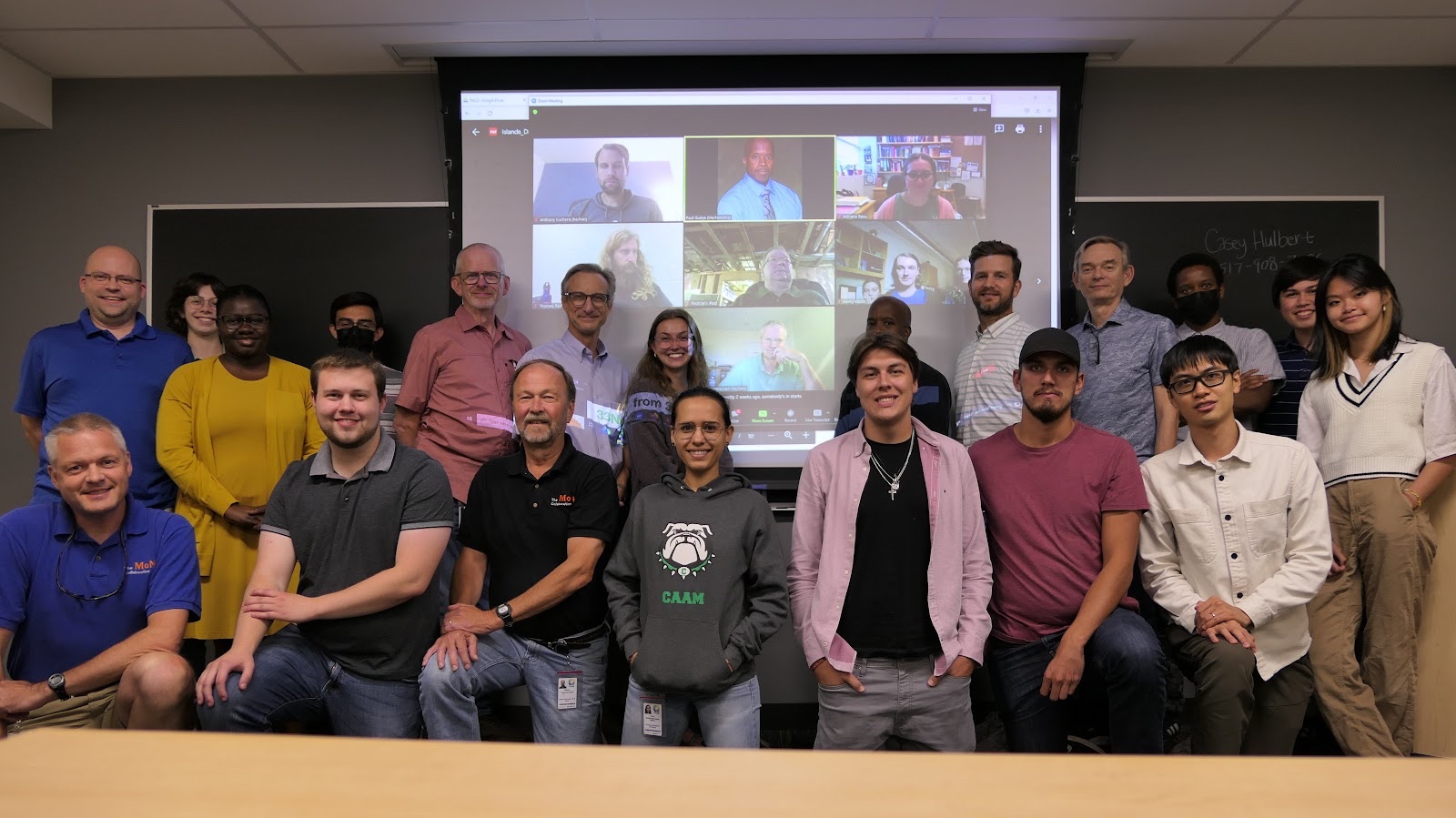
MoNA Code of Conduct adopted
The MoNA Collaboration has a long tradition of involving researchers from many different institutions, both small and large, and individuals from many different backgrounds. We believe that our commitment to diversity, equity, inclusion, and belonging will lead to the best scientific outcomes and training opportunities for young researchers. We are committed to providing productive research and educational opportunities, which is only possible through mutual respect, understanding, and fair treatment.
The MoNA Collaboration will not tolerate inappropriate actions or statements by collaboration members and collaborators. Inappropriate behaviors include harassment and derogatory or defamatory behavior (actions/language) on the basis of identity. Identity includes but is not limited to age, race, ethnicity, sexual orientation, gender identity, gender expression, marital status, nationality, political affiliation, ability, educational or socioeconomic background, neurodiversity, mental or physical health, or any other characteristic protected by law in the United States. Harassment includes but is not limited to inappropriate or intimidating behavior and/or language, unwelcome jokes or comments, unwanted touching or attention, offensive images, photography without permission, bullying, and stalking.
Thesis Defense
MoNA student Dayah Chrisman of Michign State University successfully defended her thesis: "Neutron-unbound states in the nucleus 31Ne." Congratulations Dr. Chrisman!
New publication
MoNA member Anthony Kuchera and other MoNA collaboration members working with Daniel Bazin published "Mirror nucleon removal reactions in p-shell nuclei" which used the sweeper magnet to sperate reaction products and CAESAR to detect gamma rays.
Paul Gueye earns recognition as APS Edward A. Bouchet Award winner for 2022
Please read more in the MSU/FRIB Greensheet. Paul can also be found at the seventh second of this ad by MSU.
Megan Brayton recognized for best presentation
Megan Brayton, a senior chemistry student from Virginia State University, won first place undergraduate oral presentation at the Alliances for Graduate Education and the Professoriate (AGEP) Student Success Conference hosted by Michigan State University on November 6. Megan's presentation described her research traineeship to investigate applications for machine learning to the MoNA data analysis.
MoNA student Maya Wallach featured in The Fredricksburg Free-Lance Star
The collaboration is happy to have Maya working with MoNA, and mentored by Paul Gueye! You can read more about her at The Free-Lance Star and https://nscl.msu.edu/news/news-maya.html.
DNP 2021 Update
We all missed being in Boston this year, but MoNA was well representated! The 2021 Fall Meeting of the APS Division of Nuclear Physics was held virtually October 11-14. This year’s meeting featured 21 presentations related to MoNA research. Nine presentations were given by undergraduate students, five presentations were given by graduate students, and seven presentations were given by senior members of the collaboration.
FRIB PAC 1
The first Program Advisory Committee (PAC) meeting for FRIB concluded on August 13, 2021. Eighty-two experiment proposals had been submitted to PAC1 of FRIB for evaluation of their scientific merit and feasibility. The MoNA Collaboration, working together with other researchers outside the collaboration, submitted three proposals, two of which were approved for beam time by the PAC! This is a very good outcome for the collaboration, since the proposal selection is highly competitive.
The two approved proposals are:
| 21016 | C. Hoffman | First observation of neutron-unbound 30F |
| 21066 | T. Baumann | Neutron-Unbound Excited States in 53,55Ca (approved with limited beam time to investigate 53Ca) |
These two experiments will push the invariant mass measurements of the collaboration to heavier systems. While the measurement of 30F will determine the ground-state characteristics of this unbound nucleus, the investigation of the neutron-rich 53Ca focuses on neutron-unbound excited states, which will help to pin down theoretical calculations that possibly can shed light onto the location of the neutron drip line for calcium. Only about 30% of the requested beam time could be approved, due to the high demand for FRIB.
By the numbers, the PAC-recommended experiments following peer review represent (compared to the request):
- 34 (out of 82 requested) experiments
- 3,108 hours (out of 9,784 hours) beam-on-target hours
- 4,122 facility-use hours
- 401 (out of 597) individuals
- 25 (out of 30) countries represented
- 24 U.S. states
- 88 institutions
- 15 out of 17 National Academies benchmarks for FRIB
(source: https://frib.msu.edu/news/2021/first-experiments.html)
Summer project fun!
Paul Gueye's summer student, Maya Wallach, created a fun and interesting way to display information about our research. Just click on a nucleus in the chart of the nuclides to get information about the nature of the nucleus and any of our experiments with it. Or you can play the chart like a piano. It's great fun and a novel way to display nuclear physics research.
E19013 - Last MoNA Experiment of the CCF era, completed!
With a Herculian effort by all the NSCL/FRIB members of the collaboration, a complex triple coincidence experiment to explore reactions leading to 12Be in the final state. The neutron-unbound nucleus 13Be is known to decay to 12Be + n with a relativley low resonance energy but previous experiments had left it unclear whether the ground state of 12Be or its 0+ isomer was populated in the final state. This leads to a significant ambiguity in constructing the level-scheme. To resolve this ambiguity, we performed a triple coincidence (fragment, neutron, and microsecond-delayed gamma-rays). This experiment was run in September of 2020 during the COVID pandemic. A small group of faculty, staff, post-doctorial researchers, and graduate students setup, ran the experiment, and packed away the devices. This invloved moving several miles of cables, a few tons of detectors, and synchronizing three distinct data acquisition system. Many thanks from the rest of the collaboration!
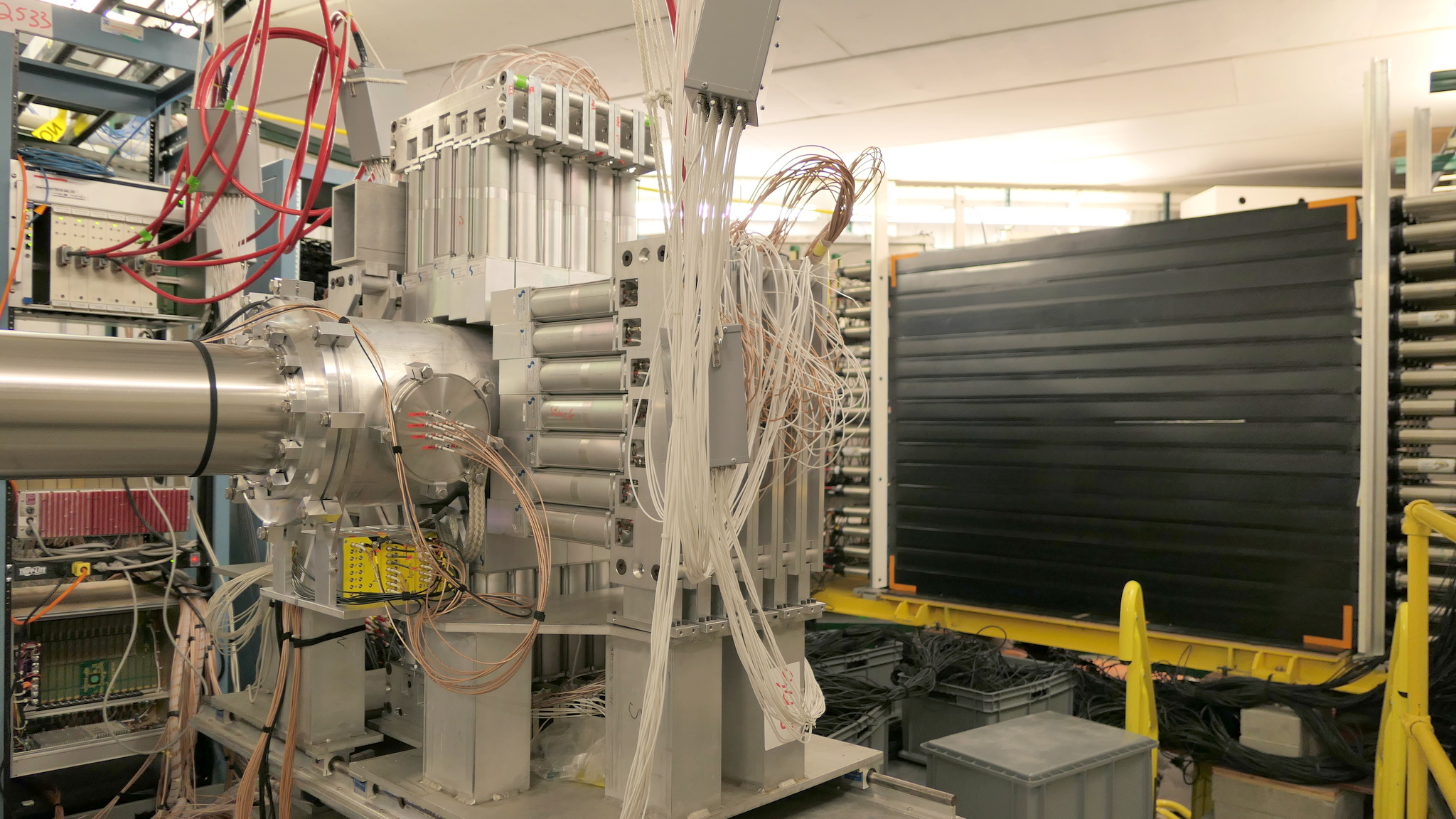 |
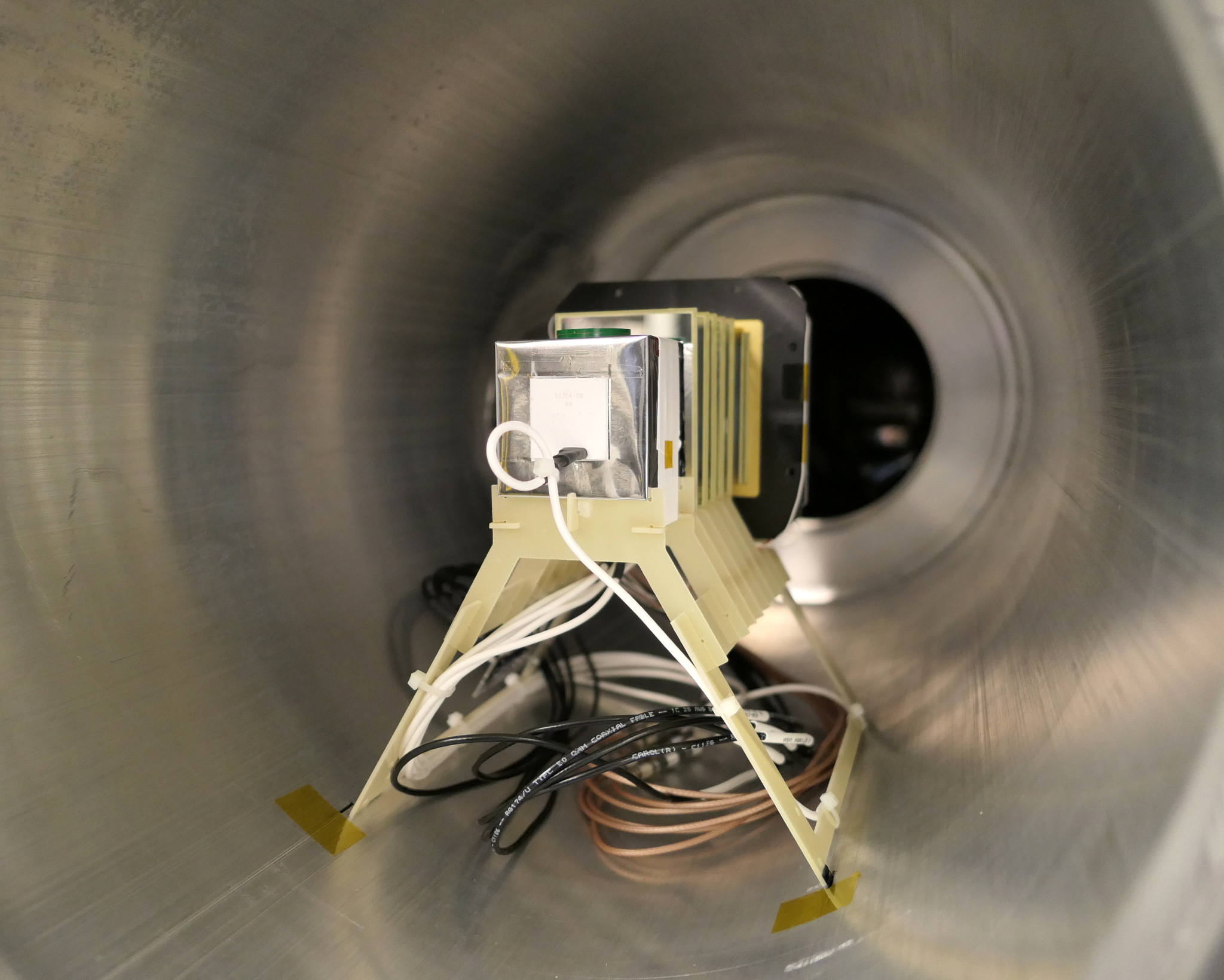 |
| Figure 1: Experimental setup showing CAESAR (CsI) surrounding the charged partcile telescope which detects delayed gamma-rays from stopped 12Be nuclei, and MoNA which detects the prompt neutrons from the in-flight decay of 13Be into 12Be + n. | Figure 2: Experimental setup showing CAESAR (CsI) surrounding the charged partcile telescope which detects and stops 12Be nuclei from the in-flight decay of 13Be. This telescope was designed, developed, and tested by Prof. Nathan Frank of Augustana College with MRI funding from the NSF (Grant 1827840). |
